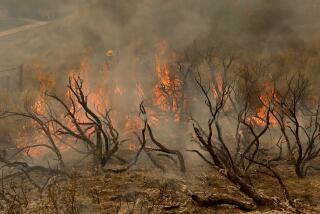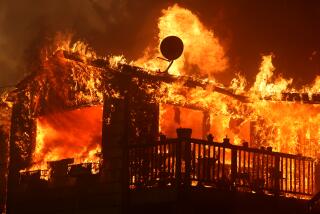âMay miracleâ of above-average rainfall is a gift to firefighters
A âMay miracleâ of almost perfectly timed, above-average rainfall helped firefighters battling the large Springs fire in Ventura County and guaranteed that Los Angeles would not break a dubious record.
The city was on track to having its fourth-driest year since 1877. But with about 0.70 inches of rain falling in downtown L.A. just before noon, that is no longer the case.
For firefighters trying to mop up the 28,000-acre wildfire that broke out last week under blistering temperatures, the rain couldnât have come at a better time â even if Southern Californiaâs fire season still looks to be an ominous one.
Tom Piranio, a spokesman for the California Department of Forestry and Fire Protection, said it didnât rain enough in the actual perimeter of the blaze for people to need an umbrella, but it was more than enough to help firefighters slow the Springs fireâs momentum. It could be fully contained by Tuesday.
âIt gave the firefighters an advantage to put out hot spots and strengthen the line,â Piranio said, adding that the rain and cooling made it easier on crews who for days had been working in temperatures approaching 100 degrees.
Bill Patzert, a climatologist at the Jet Propulsion Laboratory in La Cañada Flintridge, said that as of Monday morning, enough rain had fallen to push L.A.âs total to about 5.84 inches since July 1. That means the 2012-13 rain year, which runs from July 1 to June 30, is now the sixth-driest year on record, not the fourth.
With the rain, this year surpassed 1959, when 5.58 inches of rain fell, and 1899, which saw 5.59 inches. Patzert said it would take an unlikely amount of rainfall for this year to fall into seventh place, which belongs to 1924 when 6.67 inches fell.
âRain is always good,â he said. âThis small May miracle couldnât have been better timed in terms of the fires, because although modest, it really gives the firefighters some help.â
The Springs fire raged out of control after one of the driest winters in the 135 years since rain records have been kept for Southern California. Strong Santa Ana winds, unusual this time of the year, pushed the flames forward.
Southern California experienced an exceedingly dry stretch from January to March â normally the regionâs wettest months â and then received virtually no rainfall in April. May normally gets only about a third of an inch of rain, said Ryan Kittell, a meteorologist with the National Weather Service in Oxnard.
Patzert said the rain came courtesy of a cutoff low, in which part of the jet stream that normally comes out of the north Pacific gets pinched off and drops into a low-pressure system, which then sits off the coast for a couple of days.
âSo now it no longer has the jet stream to steer it rapidly through the Southland,â Patzert said. âIt lingers for a couple of days before passing through.â
Despite the immediate relief the rain provided firefighters, experts said that once the weather system goes away, it wonât take much for conditions to heat up and for vegetation to dry out again. And the rain doesnât change the fact that Southern California still has the driest and hottest months of the year ahead.
âItâs just a little temporary relief,â Patzert said. âA week from now youâll probably never know this happened. This is not going to change the summer and fall forecast for fires or anything else. And this is definitely no drought-buster.â
Speaking at CalFireâs aviation management unit in Sacramento, Gov. Jerry Brown said the state would have to grow accustomed to more forest fires as a consequence of global climate change. State firefighters have responded to about twice the average number of wildfires this year â more than 1,100 in all.
âOur climate is changing, the weather is becoming more intense,â Brown said in an airplane hangar filled with trucks, airplanes and helicopters used by the state to fight fires. âItâs going to cost a lot of money and a lot of lives.â
With the Sierra snowpack at just 17% of normal, state officials are bracing for a long, destructive fire season.
CalFire Director Ken Pimlott said more than 40,000 acres have burned in California this month alone.
While an early start to fire season has become more common in Southern California, officials opened the season in Northern California six weeks earlier than normal â just the fourth time in state history that has happened, Pimlott said.
More to Read
Sign up for Essential California
The most important California stories and recommendations in your inbox every morning.
You may occasionally receive promotional content from the Los Angeles Times.











